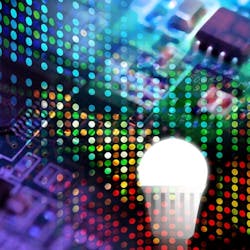Good intentions yield flicker standard with questions that remain
The recently released IEEE Std 1789-2015 that addresses safe levels of flicker in LED lighting products is generating controversy among those who believe the flicker standard to be overly restrictive.
The Institute of Electrical and Electronic Engineers (IEEE) has published a new standard that addresses flicker in LED-based lighting products — essentially defining safe levels of flicker by percentage relative to the operating frequency of a light source powered by the AC line. Presumably, IEEE Std 1789-2015, "Recommended Practice for Modulating Current in High-Brightness LEDs for Mitigating Health Risks to Viewers," was developed with good intentions intending to help guide developers of solid-state lighting (SSL) products in delivering products that are safe for consumers. But once again we are reminded that nothing about LED-based lighting is simple, and there are strong opinions that the IEEE standard is overly strict in its recommendations.
The National Electrical Manufacturers Association (NEMA) has already issued a press release questioning the recommendations in the new standard. NEMA has previously published a position paper on what it calls temporal lighting artifacts (TLAs) that address what are more typically called flicker and stroboscopic effects. The NEMA paper calls for better metrics to quantify TLAs and states that current work, including the IEEE standard, does not account for the fact that human impact depends on both frequency and the wave shape of a light source.
Related safety article: The IEC addresses characterization of the blue light hazard
What is the big deal, you ask? What would be wrong with a flicker standard that is perhaps overly strict and therefore perhaps cushioned with margins that ensure no impact of SSL on humans? NEMA and others believe that the IEEE flicker standard will result in unnecessary costs being added into LED driver electronics. And upfront cost remains the biggest roadblock to broad uptake of LED-based lighting and broader global energy savings.
Zdenko Grajcar, CTO of Once Innovations and a former executive with AC-LED advocate Seoul Semiconductor, said the IEEE standard fails to address AC-LED technology proven in the field and even would eliminate legacy lighting as safe for humans. Grajcar said incandescent and high-pressure sodium (HPS) lighting would not qualify as safe under the guidelines set by the new standard. NEMA concurs on the point about incandescent lighting. Many AC-LED products would also fail to meet the guidelines.
Of course, there are fundamental differences between incandescent and other legacy sources and LEDs. LEDs have no persistence when there is no power and quit producing light instantaneously. Incandescent and other legacy sources produce light through the zero crossing of the AC input. And the new standard was intended to apply to LED-based lighting as the title clearly indicates.
Related safety article: IEA 4E SSL Annex opines on LED impact on health and environment
Still, should the authors of the IEEE flicker standard have been less conservative? Should the authors have directly addressed AC-LED technology? Grajcar said he has seen no credible evidence that any danger exists for flicker above 75 Hz. He further has accused the IEEE 1789 committee of bias against AC-LED technology and is attempting to organize a legal challenge to the conclusions reached in the standard.
As our latest issue of LEDs Magazine was headed to press, the controversy over the new standard was just heating up. We will offer more coverage going forward.
We fully support the concept of standards as a vehicle that can enable ecosystems that both allow for profitable deployment of LED-based lighting and related technologies such as networks and controls. And a standard that defines the flicker risk is a good thing because flicker can be a serious problem. Clearly, however, such standards must be accurate and defined without bias to specific technologies. It's not clear that any bias existed in the IEEE committee and the guidelines may truly be focused on conservative bounds to ensure health. But clearly the subject of flicker will require more work.

Maury Wright | Editor in Chief
Maury Wright is an electronics engineer turned technology journalist, who has focused specifically on the LED & Lighting industry for the past decade. Wright first wrote for LEDs Magazine as a contractor in 2010, and took over as Editor-in-Chief in 2012. He has broad experience in technology areas ranging from microprocessors to digital media to wireless networks that he gained over 30 years in the trade press. Wright has experience running global editorial operations, such as during his tenure as worldwide editorial director of EDN Magazine, and has been instrumental in launching publication websites going back to the earliest days of the Internet. Wright has won numerous industry awards, including multiple ASBPE national awards for B2B journalism excellence, and has received finalist recognition for LEDs Magazine in the FOLIO Eddie Awards. He received a BS in electrical engineering from Auburn University.





